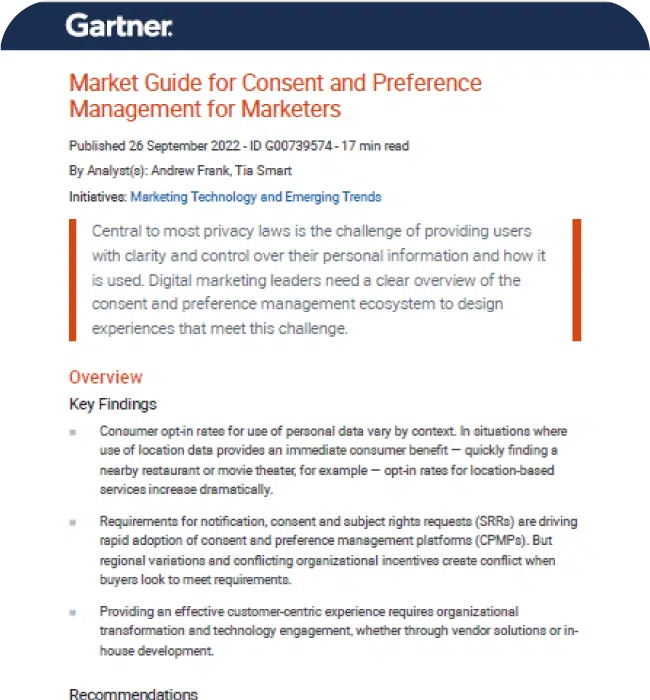5 new strategies for a post-cookie marketing world
Posted: February 24, 2023
The digital landscape constantly evolves, and marketers must adjust accordingly to stay ahead of the competition. As Google plans to phase out third-party cookies in its Chrome browser by 2024, marketing teams must prepare for a post-cookie world. This means considering other ways to collect customer data and insights so they can continue personalizing their advertisements.
This article will explore 5 ways forward-thinking marketers can thrive in a post-cookie world.
1. Leverage first-party data to gain insights into customer behavior
First-party data is the information collected directly from a company’s customers and users. This includes data obtained from online transactions, website interactions, surveys and poll results, customer service , loyalty programs, and other sources.
Marketing teams can use first-party data to learn about how customers act. This information helps them figure out what their customers want. They can also use it to create targeted campaigns and personalize their offers.
First-party data allows marketers to go beyond basic demographic info and capture individual behavior, preferences, interests and more. This helps them create more precise segmentation and improve customer experience. They can use this data to tailor their messaging and ensure they reach the right people with the right message. Additionally, they can also use first-party data to measure the success of their campaigns and get an understanding of what’s working and what isn’t.
This helps them optimize their marketing efforts for maximum impact. Ultimately, leveraging first-party data is a great way for marketers to understand their customers better, tailor their messaging, and create more effective campaigns.
2. Embrace a privacy-first mindset by being transparent about data collection methods and providing customers with control over their data
Marketing teams should be honest about how they collect data and allow customers to decide what information they share. This helps them keep their data private.
It’s important to have a robust privacy policy and use data security measures to protect customer information. This can include encryption, tokenization, and other appropriate methods. Companies should also be transparent about the data they share with third parties and allow customers to opt-out of any data-sharing activities.
Finally, companies should work hard to ensure that customer data is accurate and up-to-date by regularly verifying customers’ information and giving them access to their own data.
3. Invest in identity resolution solutions for better targeting
Identity resolution is the process of connecting disparate pieces of customer data from different sources into one unified view. Marketing teams can use identity resolution solutions to target the right people with their products. This helps them get better results from their marketing efforts.
Identity resolution solutions provide granular insights into customer data to accurately identify target audiences. Companies can use identity resolution to map identities across multiple channels, including social media, email, and mobile devices. This helps them create more personalized and tailored marketing campaigns that speak directly to their customers’ needs.
Additionally, identity resolution allows companies to track customer journeys across different marketing channels, so that they can analyze customer behavior and optimize their campaigns. With identity resolution, companies can deliver the right message to the right people at the right time, leading to more successful marketing campaigns.
4. Use AI and machine learning technologies to automate processes and optimize campaigns
AI can help marketers understand customer preferences and behavior, which allows them to create targeted campaigns. AI-powered market research tools can also gather insights into customers and their needs so businesses can deliver personalized experiences.
AI-driven automated segmentation tools can generate highly relevant messages for different customer segments quickly and efficiently. AI-enabled predictive analytics can help marketers anticipate customer demand, market trends, and other business opportunities.
AI-powered chatbots automate customer service tasks and provide 24/7 assistance to customers. This helps business reduce their operational costs while also increasing customer satisfaction.
AI-driven marketing automation tools can be used to control the entire marketing process, from scheduling campaigns to analyzing the results. This allows marketers to focus on more strategic tasks instead of spending time and resources on mundane activities.
5. Develop content strategies that are tailored to the user’s interests and needs
Marketing teams can create a content strategy tailored to the user’s interests by first understanding the needs and preferences of their target audience.
Through market research and data analysis, they can better comprehend which topics and content formats will be more appealing to their users. Additionally, understanding what platforms and channels users engage with can help marketers create a content strategy to reach the widest audience.
By focusing on high-quality, relevant content and dedicating resources to track performance, marketers can ensure their strategy is effective for short- and long-term goals. Businesses should use tracking tools to measure the success of their content and make adjustments based on customer feedback. By creating personalized content that meets customers’ needs, businesses can build strong relationships with their customers and boost sales.
How can marketing teams identify and understand their visitors with Cassie’s cookie solution?
Cassie specialises in cross-domain and cross-device consent so you can collect visitors’ consent across multiple sub domains.
If you have multiple websites and digital platforms, then Cassie is the cookie management system for you.
Cassie’s Identity Service finds solutions before you need them
If a visitor who has consented for first party cookies to be stored later deletes their cookies, or if a browser automatically removes them, Cassie can still identify them.
Read our Cassie Identity Service Data sheet to understand the problems businesses face around cookies.
Want to know how many of your visitors are using browsers with enhanced privacy features?
It’s essential for marketers and website owners to understand the implications of Intelligent Tracking Prevention (ITP) and Enhanced Tracking Protection (ETP) on their web traffic. By better understanding these features, you can adjust your marketing efforts and keep your website performance at its best.
Cassie’s Privacy Browser Calculator will provide you with accurate data that shows you exactly how ITP and ETP are affecting your web traffic.

Gartner Market Guide for Consent and Preference Management for Marketers
Central to most privacy laws is the challenge of providing users with clarity and control over their personal information and its use.
Digital marketing leaders need a clear overview of the consent and preference management ecosystem to design experiences that meet this challenge.
Read the full report by following the below:

